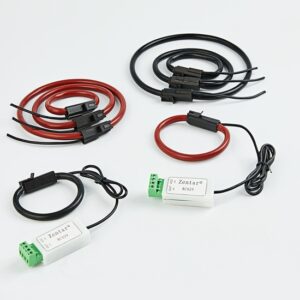In order to obtain the best suppression effect on common mode interference, the common mode inductor core must have high magnetic permeability and excellent frequency characteristics. In the past, most of the ferrite core materials used for common mode inductors have excellent frequency characteristics and low cost advantages. However, ferrite also has some insurmountable weaknesses, such as poor temperature characteristics, low saturation magnetic inductance, etc., which is subject to certain restrictions in application. In recent years, the appearance of iron-based nanocrystalline alloys has added an excellent core material for common mode inductance.
The manufacturing process of the iron-based nanocrystalline alloy is as follows: firstly, an amorphous alloy thin strip with a thickness of about 20-30 microns is made by rapid solidification technology, which is wound into an iron core and then further processed to form nanocrystals.
Compared with ferrite, nanocrystalline alloys have some unique advantages:
(1) High initial magnetic permeability:
The initial magnetic permeability of the nanocrystalline alloy can reach 100,000, which is much higher than that of ferrite. Therefore, the common mode inductor made of the nanocrystalline alloy has large impedance and insertion loss under low magnetic field. It has excellent suppression effect on weak interference.
This is especially suitable for anti-weak interference common mode filters that require very little leakage current. In some specific occasions (such as medical equipment), the equipment causes leakage current through the ground capacitance (such as the human body), which is easy to form common mode interference, and the equipment itself has extremely strict requirements on this. At this time, the use of high permeability nanocrystalline alloys to make common mode inductors may be the best choice. In addition, the high magnetic permeability of the nanocrystalline alloy can reduce the number of coil turns and reduce the distribution parameters such as parasitic capacitance, thus increasing the resonance peak frequency in the insertion loss spectrum due to the distribution parameters. At the same time, the high magnetic permeability of the nanocrystalline iron core makes the common mode inductance have higher inductance and impedance, or reduce the volume of the iron core under the premise of the same inductance.
(2) High saturation magnetic induction strength:
Bs of iron-based nanocrystalline alloys reaches 1.2T, which is more than twice that of ferrite. As a common-mode inductor core, an important principle is that the core cannot be magnetized to saturation, otherwise the inductance will decrease sharply. In practical applications, there are many occasions where the intensity of interference is large (such as high-power variable frequency motors). If ordinary ferrite is used as the common-mode inductance, there is a possibility that the iron core is saturated, and it cannot be guaranteed under high-intensity interference Noise suppression effect. Due to the high saturation magnetic induction strength of the nanocrystalline alloy, its anti-saturation characteristics are undoubtedly significantly better than ferrite, making the nanocrystalline alloy very suitable for the occasions with high current and strong interference.
(3) Flexible frequency characteristics:
Through different manufacturing processes, the nanocrystalline iron core can obtain different frequency characteristics, and with the appropriate number of coil turns, different impedance characteristics can be obtained to meet the filtering requirements of different wave bands, and the impedance value is greatly Higher than ferrite. It should be pointed out that no filter can be expected to achieve noise suppression in the entire frequency range with one iron core material, but different iron core materials, sizes and number of turns should be selected according to the filter frequency band required by the filter. Compared with ferrite, nanocrystalline alloys can be more flexible by adjusting the process to obtain the required frequency characteristics.
(4) Excellent temperature stability:
The Curie temperature of the iron-based nanocrystalline alloy is as high as 570oC or higher. In the case of large temperature fluctuations, the performance change rate of the nanocrystalline alloy is significantly lower than that of ferrite, with excellent stability, and the performance change is close to linear. Generally, in the temperature range of -50oC —- 130oC, the change rate of the main magnetic properties is within 10%. In contrast, the Curie temperature of ferrite is generally below 250oC, the rate of change in magnetic properties sometimes reaches more than 100%, and it is nonlinear and difficult to compensate. The temperature stability of the nanocrystalline alloy combined with its unique low-loss characteristics provides device designers with relaxed temperature conditions.
Since the development of iron-based nanocrystalline alloys in the late 1980s, it has been widely used in switching power supply transformers, transformers and other fields. Due to the advantages of high permeability, high saturation magnetic induction, and flexible and adjustable frequency characteristics of nanocrystalline alloys, more and more attention has been paid to fields such as anti-common mode interference filters.
There are already iron-based nanocrystalline alloy common-mode inductor cores that can be supplied in large quantities abroad. With the deepening of people’s understanding of nanocrystalline alloys, it can be expected that the domestic application of the common mode inductors they make will become more and more broad.
ZTC has a sereis of zero phase current transformer and precision current transformer used Nanacrystalline Cores to provide a high quality product with stable peformance.




